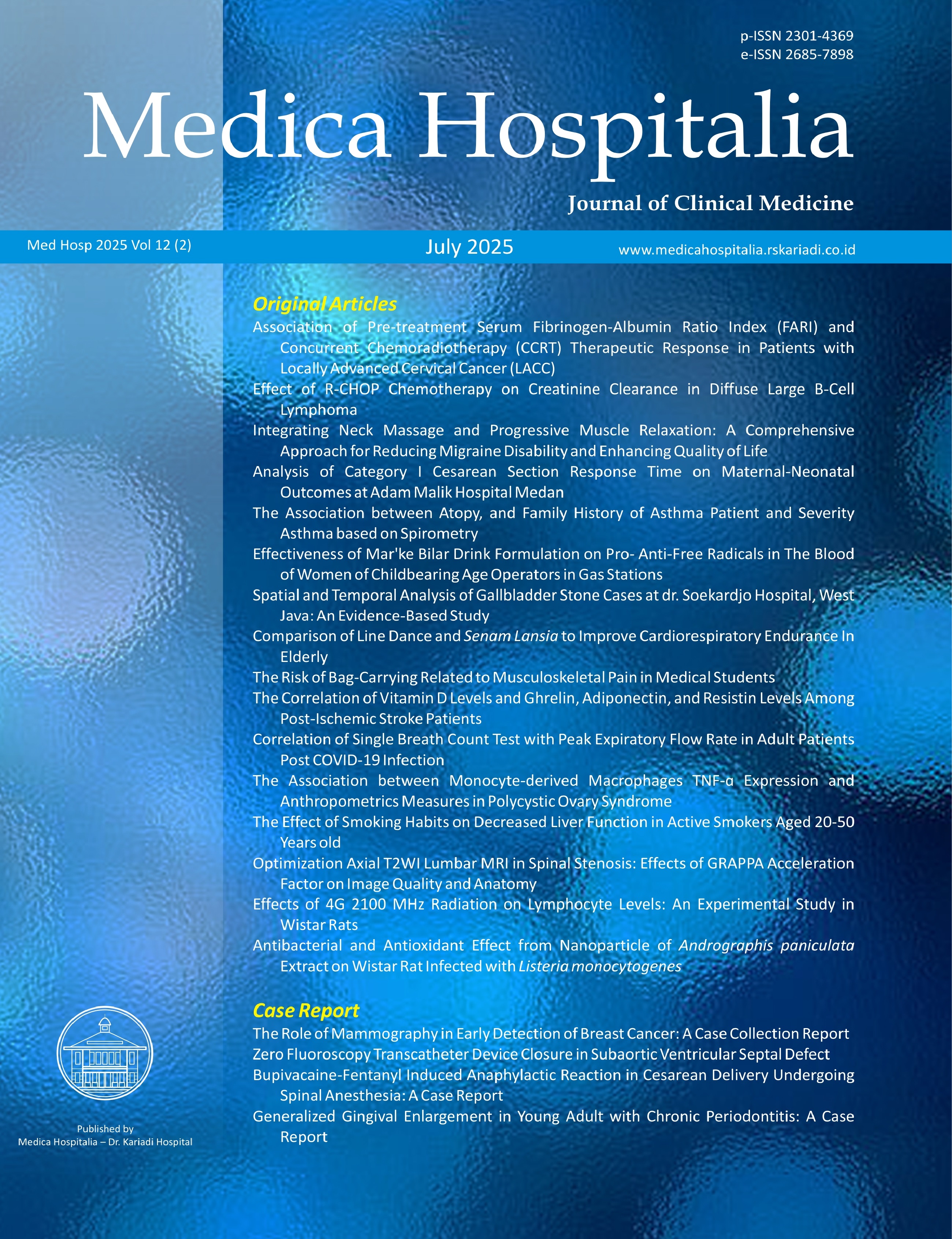The Correlation of Vitamin D Levels and Ghrelin, Adiponectin, and Resistin Levels Among Post-Ischemic Stroke Patients
DOI:
https://doi.org/10.36408/mhjcm.v12i2.1350Keywords:
Dyslipidemia, Vitamin D, Ghrelin, Adiponectin, ResistinAbstract
BACKGROUND: Dyslipidemia is one of the modifiable risk factors for stroke. The pathogenesis of dyslipidemia is through several mechanisms including adipose tissue-mediated adiponectin, resistin, and leptin secretion. Vitamin D is correlated with lipid profiles, but there is no evidence of the role of vitamin D in ghrelin, adiponectin, and resistin secretion, which may contribute to the mechanisms of the impairment of lipid profile among post-ischemic stroke.
AIMS: To determine the correlation between vitamin D and ghrelin, adiponectin, and resistin among post-ischemic stroke.
METHODS: An observational analytic study with a cross-sectional approach was conducted among forty post-ischemic stroke patients which was obtained consecutively. The serum vitamin D, ghrelin, adiponectin, and resistin levels were measured using the venous blood obtained from the median cubital vein. Data analysis was performed using the Spearman correlation test to determine the correlation between the serum vitamin D levels, ghrelin, adiponectin, and resistin levels.
RESULT: The age of our subjects is approximate 57 years old with the proportion of males being more than female subjects. There is a significant association between serum vitamin D levels and gender, total energy as well carbohydrate diet but no significant association between hormonal status and the characteristics of subjects was revealed. Furthermore, there is no significant correlation between serum vitamin D levels with the hormonal status of ghrelin, adiponectin, or resistin levels (p=0.994; 0.395; 0.858, respectively).
CONCLUSION: There is no significant correlation between serum vitamin D levels and serum ghrelin, adiponectin, or resistin levels among post-ischemic stroke patients
Downloads
References
1. Donkor ES. Stroke in the 21st Century: A Snapshot of the Burden, Epidemiology, and Quality of Life. Stroke Res Treat.2018;3238165. https://doi.org/10.1155/2018/3238165.
2. Kurth T, Everett BM, Buring JE, Kase CS, Ridker PM, Gaziano JM. Lipid levels and the risk of ischemic stroke in women. Neurology. 2007;68(8):556-62. https://doi.org/10.1212/01.wnl.0000254472.41810.0.
3. Kopin L, Lowenstein C. In the clinic. Dyslipidemia. Ann Intern Med. 2010;153(3): ITC21. http://doi.org/10.7326/0003-4819-153-3-201008030-01002.
4. Ji W, Zhou H, Wang S, Cheng L, Fang Y. Low Serum Levels of 25-Hydroxyvitamin D Are Associated with Stroke Recurrence and Poor Functional Outcomes in Patients with Ischemic Stroke. J Nutr Health Aging. 2017;21(8):892-896. https://doi.org/.1007/s12603-016-0846-3.
5. Park CY, Han SN. The Role of Vitamin D in Adipose Tissue Biology: Adipocyte Differentiation, Energy Metabolism, and Inflammation. J Lipid Atheroscler. 2021;10(2):130-144. https://doi.org/ 10.12997/jla.2021.10.2.130.
6. Abbas MA. Physiological functions of Vitamin D in adipose tissue. J Steroid Biochem Mol Biol. 2017;165(Pt B):369-381. https://doi.org/10.1016/j.jsbmb.2016.08.004.
7. Wang X, Zhang S, Li Z. Adipokines in glucose and lipid metabolism. Adipocyte. 2023 ;12(1):2202976. https://doi.org/10.1080/21623945.2023.2202976.
8. Yanai H, Yoshida H. Beneficial Effects of Adiponectin on Glucose and Lipid Metabolism and Atherosclerotic Progression: Mechanisms and Perspectives. Int J Mol Sci. 2019;20(5):1190. https://doi.org/10.3390/ijms20051190.
9. Ikeda Y, Tsuchiya H, Hama S, Kajimoto K, Kogure K. Resistin affects lipid metabolism during adipocyte maturation of 3T3-L1 cells. FEBS J. 2013;280(22):5884-95. https://doi.org/10.1111/febs.12514.
10. Perez-Tilve D, Heppner K, Kirchner H, Lockie SH, Woods SC, Smiley DL, Tschöp M, Pfluger P. Ghrelin-induced adiposity is independent of orexigenic effects. FASEB J. 2011;25(8):2814-22. https://doi.org/10.1096/fj.11-183632.
11. Lv Y, Liang T, Wang G, Li Z. Ghrelin, a gastrointestinal hormone, regulates energy balance and lipid metabolism. Biosci Rep. 2018;38(5):BSR20181061. https://doi.org/10.1042/BSR20181061.
12. Slama FB, Jridi N, Rayana MCB, Trimeche A, Hsairi M, Belhadj O. Plasma levels of leptin and ghrelin and their correlation with BMI, and circulating lipids and glucose in obese Tunisian women. Asian Biomedicine. 2015; 9(2);161-168. https://doi.org/10.5372/1905-7415.0902.382.
13. Boehme AK, Esenwa C, Elkind MS. Stroke Risk Factors, Genetics, and Prevention. Circ Res. 2017;120(3):472-495. https://doi.org/10.1161/CIRCRESAHA.116.308398.
14. Wang Y, Si S, Liu J, Wang Z, Jia H, Feng K, Sun L, Song SJ. The Associations of Serum Lipids with Vitamin D Status. PLoS One. 2016;11(10):e0165157. https://doi.org/10.1371/journal.pone.0165157.
15. Cashman KD. Vitamin D Deficiency: Defining, Prevalence, Causes, and Strategies of Addressing. Calcif Tissue Int. 2020;106(1):14-29. https://doi.org/10.1007/s00223-019-00559-4.
16. Tsiaras WG, Weinstock MA. Factors influencing vitamin D status. Acta Derm Venereol. 2011;91(2):115-24. https://doi.org/10.2340/00015555-0980.
17. Lin CH, Lin PS, Lee MS, Lin CY, Sung YH, Li ST, Weng SL, Chang SJ, Lee HC, Lee YJ, Chang HY, Lin CS. Associations between Vitamin D Deficiency and Carbohydrate Intake and Dietary Factors in Taiwanese Pregnant Women. Medicina (Kaunas). 2023 ;59(1):107. https://doi.org/10.3390/medicina59010107.
18. Jin B, Qian L, Fu X, Zhu J, Shu J. Influence of vitamin D supplementation on lipid levels in polycystic ovary syndrome patients: a meta-analysis of randomized controlled trials. J Int Med Res. 2020;48(8):300060520935313. https://doi.org/10.1177/0300060520935313.
19. Sun X, Zemel MB. Calcium and 1,25-dihydroxyvitamin D3 regulation of adipokine expression. Obesity (Silver Spring). 2007;15(2):340-8. https://doi.org/10.1038/oby.2007.540.
20. Geryk M, Kucerova V, Velganova-Veghova M, Foltenova H, Bouchalova K, Karasek D, Radvansky M Jr, Karaskova E. Association of selected adipokines with vitamin D deficiency in children with inflammatory bowel disease. BMC Pediatr. 2024;24(1):426. https://doi.org/10.1186/s12887-024-04890-0.
21. Tariq S, Tariq S, Khaliq S, Baig M, Murad MA, Lone KP. Association Between Vitamin D and Resistin in Postmenopausal Females With Altered Bone Health. Front Endocrinol (Lausanne). 2021;11:615440. https://doi.org/10.3389/fendo.2020.615440.
22. Szymczak-Pajor I, Miazek K, Selmi A, Balcerczyk A, Śliwińska A. The Action of Vitamin D in Adipose Tissue: Is There the Link between Vitamin D Deficiency and Adipose Tissue-Related Metabolic Disorders? Int J Mol Sci. 2022;23(2):956. https://doi.org/ 10.3390/ijms23020956.
23. Kong J, Chen Y, Zhu G, Zhao Q, Li YC. 1,25-Dihydroxyvitamin D3 upregulates leptin expression in mouse adipose tissue. J Endocrinol. 2013;216(2):265-71. https://doi.org/ 10.1530/JOE-12-0344.
24. Niu XH, Li L, Li JY, Song Q, Jin MM, Liu JX. Serum resistin positively correlates with serum lipids, but not with insulin resistance, in first-degree relatives of type-2 diabetes patients: an observational study in China. Medicine (Baltimore). 2017;96(16):e6622. https://doi.org/10.1097/MD.0000000000006622.
Additional Files
Published
How to Cite
Issue
Section
Citation Check
License
Copyright (c) 2025 Santoso Jaeri, Retnaningsih , Amin Husni, Nani Maharani, Gemala Anjani (Author)

This work is licensed under a Creative Commons Attribution-ShareAlike 4.0 International License.
Copyrights Notice
Copyrights:
Researchers publishing manuscrips at Medica Hospitalis: Journal of Clinical Medicine agree with regulations as follow:
Copyrights of each article belong to researchers, and it is likewise the patent rights
Researchers admit that Medica Hospitalia: Journal of Clinical Medicine has the right of first publication
Researchers may submit manuscripts separately, manage non exclusive distribution of published manuscripts into other versions (such as: being sent to researchers’ institutional repository, publication in the books, etc), admitting that manuscripts have been firstly published at Medica Hospitalia: Journal of Clinical Medicine
License:
Medica Hospitalia: Journal of Clinical Medicine is disseminated based on provisions of Creative Common Attribution-Share Alike 4.0 Internasional It allows individuals to duplicate and disseminate manuscripts in any formats, to alter, compose and make derivatives of manuscripts for any purpose. You are not allowed to use manuscripts for commercial purposes. You should properly acknowledge, reference links, and state that alterations have been made. You can do so in proper ways, but it does not hint that the licensors support you or your usage.
























